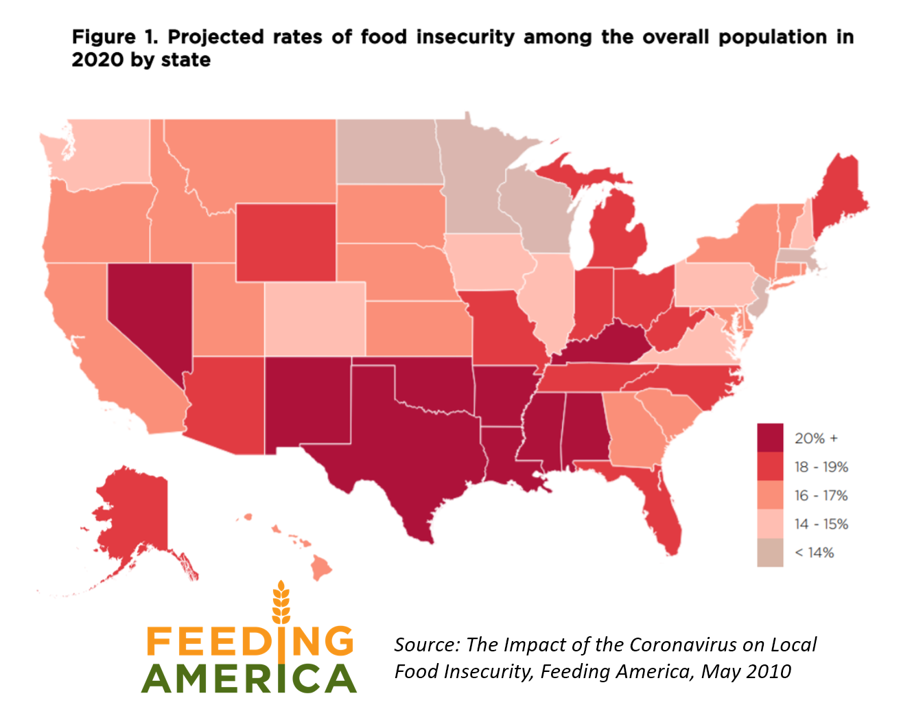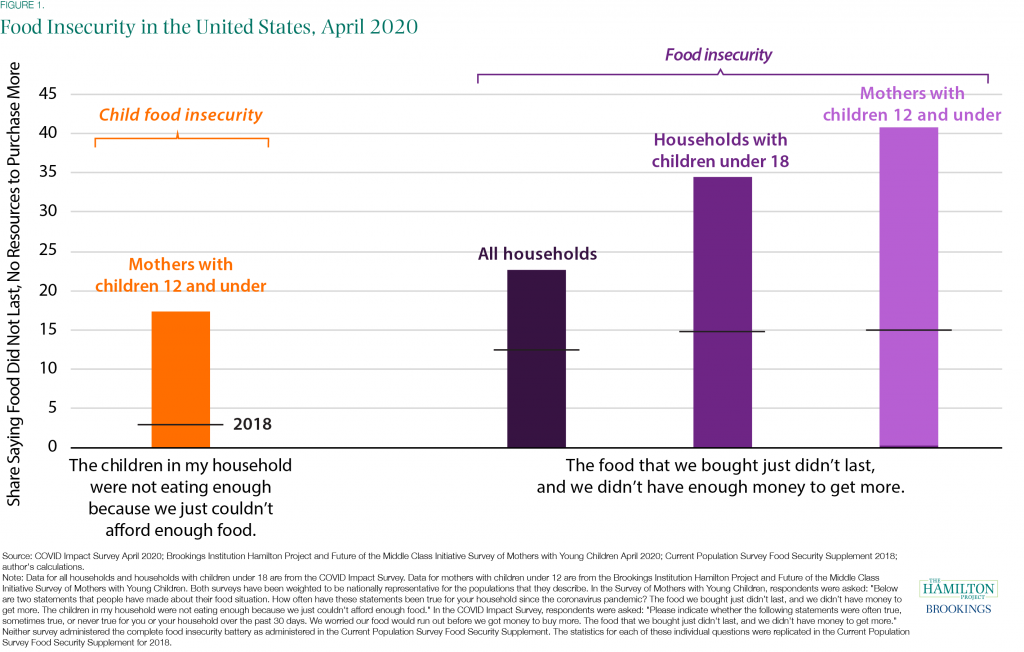The COVID-19 pandemic exacerbated food insecurity in the U.S., a situation that was already challenging for millions of American families before the public health crisis emerged.
 While several Congressional and administrative actions were implemented in 2020 and the first half of 2021, the issue of food insecurity — defined as being unable to acquire enough food due to insufficient money or resources — remains a tragic aspect of daily living for many Americans — and especially for children who live in households where jobs have been lost and incomes reduced.
While several Congressional and administrative actions were implemented in 2020 and the first half of 2021, the issue of food insecurity — defined as being unable to acquire enough food due to insufficient money or resources — remains a tragic aspect of daily living for many Americans — and especially for children who live in households where jobs have been lost and incomes reduced.
Nutrition security has also been a health risk where people lack diet quality and access to foods and beverages that promote well-being. Nutrition insecurity can lead to obesity, Type-2 diabetes, and the increasing risk of severe illness from COVID-19 and eventual hospitalization.
Enter the Bipartisan Policy Center (BPC), the think-tank that embraces “the best ideas from both parties” to bolster health, security, and opportunity for all Americans.
This week, BPC published their report on Improving Food and Nutrition Security During COVID-19, the Economic Recovery, and Beyond. On 13th September, the Center hosted a webcast featuring representatives from their Food and Nutrition Security Task Force to discuss their research and recommendations as a call-to-action that addresses the current threatening state of food insecurity, as well as opportunities to reduce the impact of future pandemics.
 The team developed nine policy recommendations to address food insecurity in the pandemic as well as to further push the economic recovery…
The team developed nine policy recommendations to address food insecurity in the pandemic as well as to further push the economic recovery…
- To develop a federal, standard definition of “nutrition security” that enables collaboration across stakeholders
- To elevate policy issues related to food/nutrition security hosting a White House Conference on the topic in early 2022
- To extend beyond the pandemic nutrition program flexibilities and waivers that provide access to federal food/nutrition assistance programs
- To support an increase in health citizens’ ability to access, avail, and consumer fruits and vegetables in all federal nutrition programs (from SNAP and WIC to EBT and USDA Emergency Food Distribution)
- To ensure technology infrastructure that provides equitable access to federal nutrition programs
- To ensure people, especially at disproportionate risk of food/nutrition insecurity, have equal access to affordable nutrition food for health; this would address the social determinants of health related to food/nutrition risks
- To provide funding for federal research and programs that address food/nutrition security impacted by COVID-19 and to prevent adverse outcomes in future public health emergencies
- To develop and implement programs targeting communities disproportionately impacted by COVID-19 relative to obesity and diet-related chronic conditions — namely, communities of color; and,
- To maintain program flexibilities, increase investments in emergency food assistance, and incentivize the distribution of foods to families to increase access to nutritious food boosting dietary quality.
 The Task Force included experts from across the food-health ecosystem, co-chaired by:
The Task Force included experts from across the food-health ecosystem, co-chaired by:
- Chef José Andrés, Founder of World Central Kitchen
- Dan Glickman, Former USDA Secretary
- Leslie Sarasin, President and CEO of the Food Industry Association (FMI), and
- Ann Veneman, Former USDA Secretary.
In addition, Task Force members include Pam Schwartz, Executive Director, Community Health, Kaiser Permanente, who joined the four co-chairs on the broadcast, along with representatives from Feeding America, the Nation WIC Association, the American Farm Bureau Federation, Amazon, and many others spanning the food and nutrition industry.
“Amazon?” you ask. See the Hot Points, below.
Chef Andres, a hero to so many of us, quoted the French philosophy Jean Anthelme Brillat-Savarin, who famously said, “The destiny of nations depends upon the manner in which they feed themselves.”
Brillat-Savarin wrote that in his treatise, The physiology of taste. But the ethos in that sentence, written in 1825, feels particularly timely today.
Pam Schwartz of Kaiser-Permanente provided a healthcare-pragmatic voice in the conversation, discussing the prospects for food-as-medicine, SNAP nutrition programs, produce prescriptions, and medically-tailored meals. K-P is involved in several studies to learn more about and build evidence for food in health, looking at various chronic conditions as well as COVID-19 era learnings.
“Addressing food insecurity requires all hands on deck,” Schwartz said.
 Health Populi’s Hot Points: In their report’s conclusion, the BPC Nutrition Task Force connects the dots between food, health, and the national economy:
Health Populi’s Hot Points: In their report’s conclusion, the BPC Nutrition Task Force connects the dots between food, health, and the national economy:
“While we do not know if or when there will be another pandemic, by implementing the evidence-based, bipartisan policy recommendations in this brief, we may be able to reduce the impact of a future public health emergency, recession, or economic downturn on food and nutrition security, and our nation’s health and well-being.”
Nearly 100 years ago (and 100 years after Brillat-Savarin’s treatise on the politics of gastronomy), Armour and Company published this food source map, a tool to educate the public on the importance of the agricultural industry in America for peoples’ nutrition and the nation’s economy.
This was a key channel for Americans’ health and well-being, in its time.
Today, and especially in the wake of the COVID-19 pandemic, we have turned to ecommerce, food delivery services, and technology-enabled scaling of getting that basic human need — food, nutrition — to people, wherever we live.
We now recall that Amazon had a seat on the BPC Food and Nutrition Security Task Force table: that was Kristina Herrmann, Director of Underserved Populations in Amazon.
“Will people enrolled in Medicaid want to be Amazon Prime’d?” I asked in this blog in 2018. That was when Amazon announced plans to extend Prime subscriptions to people enrolled in Medicaid for the discount price of $5.99 a month instead of the recent price increase to $12.99/month or $99 a year. Folks could tie their benefit card to the Amazon account, thus expanding Prime to a new group of potential member-consumers.
The year before, Amazon began to test tying SNAP nutrition benefits to the Amazon pantry food channel.
As Kaiser-Permanente’s Pam Schwartz attested, we need “all hands on deck” to solve the food/nutrition security challenge in America. Amazon and other tech-enabled partners will be part of the solution to this intractable, multi-pronged goal.

In closing, each of us has an opportunity to show kindness at least once every single day. The American Psychological Association discusses The case for kindness on their website, presenting the evidence base on being kind.
Through 21st September, the APA is inviting all of us to commit to doing something kind — from practicing kindness to ourselves as well as to others. APA offers some examples, such as sending five kind notes, sharing a funny joke or an uplifting story with a friend.
Or we can channel the theme of food security by sharing food or a shopping gift card with a family you may or may not know. Your faith institution can connect you, or the local Y or town or county food bank.
#BeKind21 and #FeedTheHungry.





 I'm gobsmackingly happy to see my research cited in a new, landmark book from the National Academy of Medicine on
I'm gobsmackingly happy to see my research cited in a new, landmark book from the National Academy of Medicine on 
 Grateful to Gregg Malkary for inviting me to join his podcast
Grateful to Gregg Malkary for inviting me to join his podcast